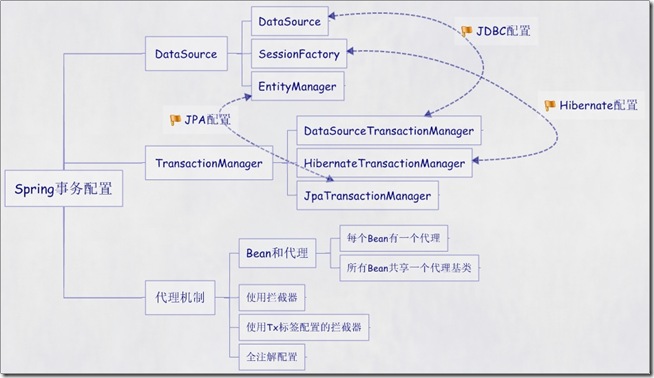具体如下图:
根据代理机制的不同,总结了五种Spring事务的配置方式,配置文件如下:
第一种方式:每个Bean都有一个代理
< beans xmlns ="http://www.springframework.org/schema/beans"
xmlns:xsi ="http://www.w3.org/2001/XMLSchema-instance"
xmlns:context ="http://www.springframework.org/schema/context"
xmlns:aop ="http://www.springframework.org/schema/aop"
xsi:schemaLocation ="http://www.springframework.org/schema/beans
http://www.springframework.org/schema/beans/spring-beans-2.5.xsd
http://www.springframework.org/schema/context
http://www.springframework.org/schema/context/spring-context-2.5.xsd
http://www.springframework.org/schema/aop http://www.springframework.org/schema/aop/spring-aop-2.5.xsd" >
< bean id ="sessionFactory"
class ="org.springframework.orm.hibernate3.LocalSessionFactoryBean" >
< property name ="configLocation" value ="classpath:hibernate.cfg.xml" />
< property name ="configurationClass" value ="org.hibernate.cfg.AnnotationConfiguration" />
</ bean >
<!-- 定义事务管理器(声明式的事务) -->
< bean id ="transactionManager"
class ="org.springframework.orm.hibernate3.HibernateTransactionManager" >
< property name ="sessionFactory" ref ="sessionFactory" />
</ bean >
<!-- 配置DAO -->
< bean id ="userDaoTarget" class ="com.bluesky.spring.dao.UserDaoImpl" >
< property name ="sessionFactory" ref ="sessionFactory" />
</ bean >
< bean id ="userDao"
class ="org.springframework.transaction.interceptor.TransactionProxyFactoryBean" >
<!-- 配置事务管理器 -->
< property name ="transactionManager" ref ="transactionManager" />
< property name ="target" ref ="userDaoTarget" />
< property name ="proxyInterfaces" value ="com.bluesky.spring.dao.GeneratorDao" />
<!-- 配置事务属性 -->
< property name ="transactionAttributes" >
< props >
< prop key ="*" > PROPAGATION_REQUIRED </ prop >
</ props >
</ property >
</ bean >
</ beans >
第二种方式:所有Bean共享一个代理基类
< beans xmlns ="http://www.springframework.org/schema/beans"
xmlns:xsi ="http://www.w3.org/2001/XMLSchema-instance"
xmlns:context ="http://www.springframework.org/schema/context"
xmlns:aop ="http://www.springframework.org/schema/aop"
xsi:schemaLocation ="http://www.springframework.org/schema/beans
http://www.springframework.org/schema/beans/spring-beans-2.5.xsd
http://www.springframework.org/schema/context
http://www.springframework.org/schema/context/spring-context-2.5.xsd
http://www.springframework.org/schema/aop http://www.springframework.org/schema/aop/spring-aop-2.5.xsd" >
< bean id ="sessionFactory"
class ="org.springframework.orm.hibernate3.LocalSessionFactoryBean" >
< property name ="configLocation" value ="classpath:hibernate.cfg.xml" />
< property name ="configurationClass" value ="org.hibernate.cfg.AnnotationConfiguration" />
</ bean >
<!-- 定义事务管理器(声明式的事务) -->
< bean id ="transactionManager"
class ="org.springframework.orm.hibernate3.HibernateTransactionManager" >
< property name ="sessionFactory" ref ="sessionFactory" />
</ bean >
< bean id ="transactionBase"
class ="org.springframework.transaction.interceptor.TransactionProxyFactoryBean"
lazy-init ="true" abstract ="true" >
<!-- 配置事务管理器 -->
< property name ="transactionManager" ref ="transactionManager" />
<!-- 配置事务属性 -->
< property name ="transactionAttributes" >
< props >
< prop key ="*" > PROPAGATION_REQUIRED </ prop >
</ props >
</ property >
</ bean >
<!-- 配置DAO -->
< bean id ="userDaoTarget" class ="com.bluesky.spring.dao.UserDaoImpl" >
< property name ="sessionFactory" ref ="sessionFactory" />
</ bean >
< bean id ="userDao" parent ="transactionBase" >
< property name ="target" ref ="userDaoTarget" />
</ bean >
</ beans >
第三种方式:使用拦截器
< beans xmlns ="http://www.springframework.org/schema/beans"
xmlns:xsi ="http://www.w3.org/2001/XMLSchema-instance"
xmlns:context ="http://www.springframework.org/schema/context"
xmlns:aop ="http://www.springframework.org/schema/aop"
xsi:schemaLocation ="http://www.springframework.org/schema/beans
http://www.springframework.org/schema/beans/spring-beans-2.5.xsd
http://www.springframework.org/schema/context
http://www.springframework.org/schema/context/spring-context-2.5.xsd
http://www.springframework.org/schema/aop http://www.springframework.org/schema/aop/spring-aop-2.5.xsd" >
< bean id ="sessionFactory"
class ="org.springframework.orm.hibernate3.LocalSessionFactoryBean" >
< property name ="configLocation" value ="classpath:hibernate.cfg.xml" />
< property name ="configurationClass" value ="org.hibernate.cfg.AnnotationConfiguration" />
</ bean >
<!-- 定义事务管理器(声明式的事务) -->
< bean id ="transactionManager"
class ="org.springframework.orm.hibernate3.HibernateTransactionManager" >
< property name ="sessionFactory" ref ="sessionFactory" />
</ bean >
< bean id ="transactionInterceptor"
class ="org.springframework.transaction.interceptor.TransactionInterceptor" >
< property name ="transactionManager" ref ="transactionManager" />
<!-- 配置事务属性 -->
< property name ="transactionAttributes" >
< props >
< prop key ="*" > PROPAGATION_REQUIRED </ prop >
</ props >
</ property >
</ bean >
< bean class ="org.springframework.aop.framework.autoproxy.BeanNameAutoProxyCreator" >
< property name ="beanNames" >
< list >
< value > *Dao </ value >
</ list >
</ property >
< property name ="interceptorNames" >
< list >
< value > transactionInterceptor </ value >
</ list >
</ property >
</ bean >
<!-- 配置DAO -->
< bean id ="userDao" class ="com.bluesky.spring.dao.UserDaoImpl" >
< property name ="sessionFactory" ref ="sessionFactory" />
</ bean >
</ beans >
第四种方式:使用tx标签配置的拦截器
< beans xmlns ="http://www.springframework.org/schema/beans"
xmlns:xsi ="http://www.w3.org/2001/XMLSchema-instance"
xmlns:context ="http://www.springframework.org/schema/context"
xmlns:aop ="http://www.springframework.org/schema/aop"
xmlns:tx ="http://www.springframework.org/schema/tx"
xsi:schemaLocation ="http://www.springframework.org/schema/beans
http://www.springframework.org/schema/beans/spring-beans-2.5.xsd
http://www.springframework.org/schema/context
http://www.springframework.org/schema/context/spring-context-2.5.xsd
http://www.springframework.org/schema/aop http://www.springframework.org/schema/aop/spring-aop-2.5.xsd
http://www.springframework.org/schema/tx http://www.springframework.org/schema/tx/spring-tx-2.5.xsd" >
< context:annotation-config />
< context:component-scan base-package ="com.bluesky" />
< bean id ="sessionFactory"
class ="org.springframework.orm.hibernate3.LocalSessionFactoryBean" >
< property name ="configLocation" value ="classpath:hibernate.cfg.xml" />
< property name ="configurationClass" value ="org.hibernate.cfg.AnnotationConfiguration" />
</ bean >
<!-- 定义事务管理器(声明式的事务) -->
< bean id ="transactionManager"
class ="org.springframework.orm.hibernate3.HibernateTransactionManager" >
< property name ="sessionFactory" ref ="sessionFactory" />
</ bean >
< tx:advice id ="txAdvice" transaction-manager ="transactionManager" >
< tx:attributes >
< tx:method name ="*" propagation ="REQUIRED" />
</ tx:attributes >
</ tx:advice >
< aop:config >
< aop:pointcut id ="interceptorPointCuts"
expression ="execution(* com.bluesky.spring.dao.*.*(..))" />
< aop:advisor advice-ref ="txAdvice"
pointcut-ref ="interceptorPointCuts" />
</ aop:config >
</ beans >
第五种方式:全注解
< beans xmlns ="http://www.springframework.org/schema/beans"
xmlns:xsi ="http://www.w3.org/2001/XMLSchema-instance"
xmlns:context ="http://www.springframework.org/schema/context"
xmlns:aop ="http://www.springframework.org/schema/aop"
xmlns:tx ="http://www.springframework.org/schema/tx"
xsi:schemaLocation ="http://www.springframework.org/schema/beans
http://www.springframework.org/schema/beans/spring-beans-2.5.xsd
http://www.springframework.org/schema/context
http://www.springframework.org/schema/context/spring-context-2.5.xsd
http://www.springframework.org/schema/aop http://www.springframework.org/schema/aop/spring-aop-2.5.xsd
http://www.springframework.org/schema/tx http://www.springframework.org/schema/tx/spring-tx-2.5.xsd" >
< context:annotation-config />
< context:component-scan base-package ="com.bluesky" />
< tx:annotation-driven transaction-manager ="transactionManager" />
< bean id ="sessionFactory"
class ="org.springframework.orm.hibernate3.LocalSessionFactoryBean" >
< property name ="configLocation" value ="classpath:hibernate.cfg.xml" />
< property name ="configurationClass" value ="org.hibernate.cfg.AnnotationConfiguration" />
</ bean >
<!-- 定义事务管理器(声明式的事务) -->
< bean id ="transactionManager"
class ="org.springframework.orm.hibernate3.HibernateTransactionManager" >
< property name ="sessionFactory" ref ="sessionFactory" />
</ bean >
</ beans >
此时在DAO上需加上@Transactional注解,如下:
import java.util.List;
import org.hibernate.SessionFactory;
import org.springframework.beans.factory.annotation.Autowired;
import org.springframework.orm.hibernate3.support.HibernateDaoSupport;
import org.springframework.stereotype.Component;
import com.bluesky.spring.domain.User;
@Transactional
@Component( " userDao " )
public class UserDaoImpl extends HibernateDaoSupport implements UserDao {
public List < User > listUsers() {
return this .getSession().createQuery( " from User " ).list();
}

}
<prop key="load*">PROPAGATION_REQUIRED,readOnly</prop><prop key="store*">PROPAGATION_REQUIRED</prop>
估计有好多朋友还没有弄清楚里面的值的意思,仔细看完下面应该知道自己什么情况下面应该使用什么样的声明。^_^
Spring中常用事务类型:
PROPAGATION_REQUIRED (propagation_required)--支持当前事务,如果当前没有事务,就新建一个事务。这是最常见的选择。
PROPAGATION_SUPPORTS(propagation_supports)--支持当前事务,如果当前没有事务,就以非事务方式执行。
PROPAGATION_MANDATORY(propagation_mandatory)--支持当前事务,如果当前没有事务,就抛出异常。
PROPAGATION_REQUIRES_NEW(propagation_requires_new)--新建事务,如果当前存在事务,把当前事务挂起。
PROPAGATION_NOT_SUPPORTED(propagation_not_support)--以非事务方式执行操作,如果当前存在事务,就把当前事务挂起。
PROPAGATION_NEVER(propagation_never)--以非事务方式执行,如果当前存在事务,则抛出异常。
PROPAGATION_NESTED(propagation_nested)--如果当前存在事务,则在嵌套事务内执行。如果当前没有事务,则进行与PROPAGATION_REQUIRED类似的操作。
Transaction后缀给声明式事务管理带来的好处
良好的面向对象的程序,一般都使用接口和实现分离的模式。我在《事务管理最佳实践全面解析》一文中提出,用*Transaction和*Dao后缀这样的形式,区分方法的不同用途。
这样,可以提醒接口的实现者和方法的使用者注意到它们对于数据库连接和事务的依赖。
实际上,使用*Transaction后缀这样的命名方式,对于声明式事务管理也是很有用处的。如,Spring的事务管理中,我们一般使用方法名的匹配来应用声明式事务。
一、请看下面的Spring配置:

























 2489
2489

 被折叠的 条评论
为什么被折叠?
被折叠的 条评论
为什么被折叠?








